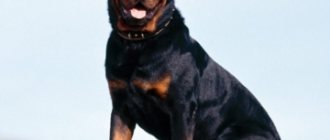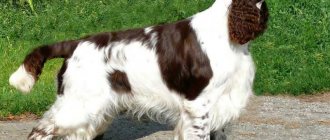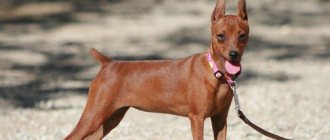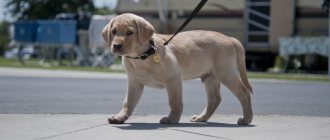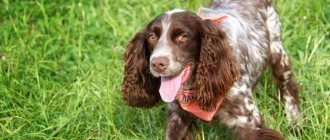Timely training of a Rottweiler will help the owner keep it under control. Dogs of this breed need courses to develop certain skills. Otherwise, it will not only be impossible to use the Rottweiler as a service dog, but even to go outside with it. In this article we will introduce you to the basic training courses that you should know.
Why is training needed?
When teaching a Rottweiler puppy basic skills, the owner gets the opportunity to study his individual abilities and character. Based on the knowledge gained, the owner gradually removes the dog’s unwanted habits and corrects its behavior.
A dog's behavior shapes its interaction with its environment. It changes under the influence of external and internal factors. An untrained dog satisfies only its own needs: food, self-defense, procreation, and so on.
The Rottweiler is a service dog capable of protecting its owner, his family and property from intruders. However, you can use the skills of an animal only after completing training courses with it. Let's look at how to train a dog at different stages of its life.
It is important to know
Dogs of this breed have high learning abilities. However, there is a distinctive feature - a slow reaction. That is, the transition from one state to another is slightly inhibited.
The owner should take this nuance into account during training so as not to get irritated. Otherwise, there is a high probability that your dog will unknowingly develop bad habits, such as uncontrollable aggression.
But Rottweilers have learned lessons firmly in their memory. It will take a lot of time to teach a dog of this breed basic commands and skills. However, in the future it is possible to reduce the number of training hours by a third. In this case, the results will be the same as with other service breeds.
Team "Come to me"
The first rule that a dog owner must remember is consistency in literally everything. There is a purchased Rottweiler puppy, training which is not too difficult, but requires patience; you need to immediately train it at a certain time and in the right place. The animal must have its own bowl.
Before pouring food into it, the owner should lightly tap it on the floor. Such actions should be repeated periodically. After some time, the Rottweiler puppy will understand what this sound means and will run to the kitchen to the filled bowl. In the future, the knock will simply need to be supplemented with the command “Come to me.” This technology will help your puppy develop a lasting skill.
Basic rules of training
So that the dog can be safely trained, it is necessary to show it from the first meeting who is boss in the house. It is necessary to determine once and for all the boundaries of what is permitted for the animal and never deviate from your decision.
Having given the dog a command, it is necessary to ensure its complete execution. You cannot move on to the next one until the previous one has been thoroughly studied. Jumping from command to command can not only confuse the dog. For a Rottweiler, an order may become meaningless and she will refuse to carry it out.
If a dog does something wrong, it does not mean that he is stupid or disobedient. In most cases, erroneous execution of commands or actions is the result of poor or incorrect training.
During training, you need to monitor your physical and mental condition. Any strange behavior in the dog, excessive excitability or anxiety is a reason to skip the lesson, giving the animal time to rest. If your Rottweiler is not feeling well, it is best to consult a veterinarian for advice. Perhaps he got sick. In case of illness, training can be continued only two weeks after the animal has fully recovered.
It is necessary to communicate with the dog in a language it understands, showing the expediency of the task. All commands must be short and given clearly, quickly, with a certain intonation. Reinforcement, which will be discussed below, will tell the animal that he will receive a reward if he obeys.
Demanding the impossible from your pet can tire him out, make him angry and disappoint him. In any case, the dog may stop obeying its owner. The requirements must be commensurate with the capabilities of the animal.
You cannot deceive your dog during training. If you give the command to “walk”, and instead of the promised walk you give him an injection, most likely he will stop trusting the person who deceived him. Training will turn into a burden if the trusting contact between the owner and the dog is broken.
You need to carefully monitor the “purity” of the dog’s execution of the command. If you ignore the incorrect position of the Rottweiler after the “sit” command, it will subsequently be difficult to teach him an even exhibition stance.
Training should be enjoyable for both owner and dog. Therefore, it is better to carry it out in the form of a game and in the fresh air. Usually a day you work with the dog three to four times for fifteen minutes. The time and number of classes may vary under the influence of various factors: poor health of the dog or owner, unsuitable weather conditions, and so on.
It is advisable to end each session with a command that the dog knows well. After completing the command correctly, you need to praise and treat it with a treat. In this case, both the owner and the pet will have a pleasant feeling of achieved success until the next training session.
Raising a 2 month old Rottweiler puppy
At 2 months old, your Rottweiler puppy is still at home, in quarantine after the first vaccinations, and he is not yet allowed to go for walks. Therefore, it’s time to start raising a puppy in familiar home conditions.
The first step is teaching the puppy to go to the toilet in a diaper . At the same time, it should be remembered that any learning is a rather complex thing, and when you see the first positive results, you should not think that your puppy has already understood everything, but you should continue training according to the method, so that after a while you do not have to start all over again.
The second important point will be to accustom the puppy to a collar and leash . Yes, yes, this should be done at home, so that by the time the puppy goes outside for the first time, wearing a collar will not be additional stress for him, but is already a familiar thing, and he can begin to explore the world around him, rather than trying get rid of an unknown object.
The third point, which causes the greatest difficulties for new puppy owners, will be the definition of the puppy’s boundaries of what is permitted :
- Teach to play only with your toys, and not with your things;
- Explain that you cannot bite your hands even in a game;
- Establish the correct daily routine, establishing the rule that in the morning you need to sleep and not wake you up;
- Stop chewing furniture, clothes, walls and baseboards;
- Teach to stay home alone, knowing that your absence is not a reason to bark or howl.
Reward and Punishment
From the very beginning of training, treats can be used as a reward to practice commands. For each correct execution of a command, the dog is rewarded with his favorite food: pieces of apple, low-fat cheese, dry food granules. Rottweilers have a highly developed reaction to food. Therefore, the treat helps to quickly consolidate the necessary skills and retain them in the dog’s memory.
Reward in the form of treats establishes a trusting relationship between the owner and the Rottweiler. Food also keeps the dog active during training. As a result, she feels good, despite the fatigue after classes. For the treat to help with training, the dog must be half-starved. Training should begin three to four hours after eating.
Instead of treats, you can use petting and friendly pats. It all depends on what the Rottweiler likes best. The dog will gladly follow the trainer's commands if there is a reward waiting for it.
At five to six months, the Rottweiler may begin to show temper and get out of control. If treats and friendly gestures no longer help in training, you will have to punish him for disobedience.
The main punishments for a Rottweiler include being lifted from the ground and lightly shaking, covering the animal's muzzle with a hand for a short period of time, a severe reprimand, and lack of encouragement.
The main thing in punishment is not to overdo it. If the owner causes the Rottweiler severe pain and shows him his anger, the dog may become angry in response. It is very difficult to get the animal back under control.
Basics: first teams
Where should training begin? The Rottweiler is a smart dog, and you should start learning simple commands with it immediately after acquiring it. A small dog can also be taught certain skills. From the age of one and a half months, a Rottweiler usually begins to learn commands such as:
Of course, when training, you should not shout too loudly at the puppy, much less hit him. This can make a dog of even a calm and balanced breed like the Rottweiler very nervous.
Training a puppy will be much more successful if the owner prefers to use not only punishment, but also praise in the training process. You can encourage your dog with some treats. Punishment should only be used as a last resort. If the puppy flatly does not want to obey, you just need to take him by the withers, lift him and put him back on his feet.
Basic obedience course
Training a Rottweiler begins from the first day it arrives in the house. Moreover, basic training goes simultaneously with education. The dog must unquestioningly follow basic commands and be able to behave correctly both within the family and in public places.
You can familiarize yourself with the initial training and education of a Rottweiler at home and on the street in the article “Rules for raising a Rottweiler.”
What a Rottweiler should learn at different stages of its life can be found in the following table:
Getting to know society
Rottweiler training, characterized by the puppy’s introduction to society, should occur between 8 and 12 weeks. A dog at this age is distinguished by its mobility - doggies quite actively begin to explore the world around them. This is expressed in the study and testing of the strength of objects that are in the apartment.
Raising a Rottweiler should be carried out from childhood. At 6 months of age, the puppy’s character traits already become noticeable. During this period, you can independently think through the tactics that characterize his training.
Exhibition training
It is necessary to begin preparing a Rottweiler for exhibitions from two to three months. The sooner training begins, the better the dog will behave at shows. The Rottweiler should be comfortable around large crowds of people and do the following:
- show bite and teeth on command;
- trot the prescribed number of laps next to the owner;
- trot with the owner along a straight road from the judge and back;
- stand on command in an exhibition stand and stand motionless for the designated number of minutes;
- do not show any signs of anxiety during the manual examination by the judge.
General training course
From six to twelve months, you can prepare a Rottweiler to pass the official standards for OKD - a general training course.
During the exam, it is checked how the Rottweiler sits down on command, lies down, approaches the owner and returns to his place, brings an object, stops an unwanted action, does not pick up scattered food from the ground, and shows his teeth. The dog is checked for endurance, attitude towards the muzzle and leash. By order of the owner, the Rottweiler must, without delay or fear, go through an obstacle course: low and high barriers, stairs and others.
After practicing any command of the judge's choice, the Rottweiler's attitude to the shot from the starting pistol is checked. You cannot shoot while the dog is moving near the owner or while an object is being presented. The shot is fired at a distance of fifteen meters from the dog. For the shot to be sudden, the animal must not see the person with the gun.
Throughout the test, the judges evaluate their impression of the overall performance that the dog was able to demonstrate.
Protective guard service
ZKS (protective guard service) is a special training developed by Soviet dog handlers. The training is aimed at developing the dog’s security and protective functions, as well as the ability to follow a scent and search for various objects by smell. A special course is used in law enforcement agencies to train dogs for guard, search and other services.
However, such a course is not entirely appropriate in everyday life. Therefore, the amateur ZKS course is becoming increasingly popular among Rottweiler lovers. With its help, dogs are trained to protect the owner, his family, property and home.
After completing the course, the Rottweiler acquires the skills to detain a criminal and guard him until the owner arrives, to keep the situation under control, without reacting to any sounds, thrown food, or bright light.
To take the ZKS course, the Rottweiler cannot be younger than twelve months. The dog must be mentally and physically healthy, without external defects, such as an incomplete set of teeth, poor eyesight or hearing.
In addition, for the amateur course it is necessary that the Rottweiler unquestioningly carry out basic obedience commands. For a special ZKS course, it is necessary for the dog to successfully pass the OKD exam (general training course) and receive a certificate from the RKF (Russian Canine Federation).
Manageable city dog
If there is no opportunity or desire to take official exams on a general training course with your Rottweiler, you can train your Rottweiler in the UGS course - a controlled city dog. Unlike OKD, where the assessment of completed tasks will be given by specialists of the Russian Canine Federation, the UGS course is held in any dog breeding club. Therefore, instead of an RKF certificate, the owner of a Rottweiler can only receive a club diploma.
Taking a city dog management course is especially recommended for owners who live in the city and constantly appear with their Rottweiler in public places. Training begins at six months.
The UGS course is designed to develop a Rottweiler into a companion who knows how to behave correctly in city conditions. However, there are more requirements in this course than in OKD. After all, work with dogs is carried out not only in closed dog parks, but also in other areas where there are many unpredictable urban factors and outsiders.
After completing the UGS course, the Rottweiler will learn the following:
- follow the commands “near”, “sit”, “lie down”, “stand”, “come to me”, “no”, “fu”;
- treat walking accessories calmly: leash, muzzle;
- do not show signs of anxiety during a manual examination of teeth, fur, ears, paws;
- calmly go out or enter the entrance, car, clinic, and so on;
- calmly cross an overground or underground pedestrian crossing;
- be comfortable on public transport;
- do not accept food from strangers;
- do not pick up food or dirty objects from the ground;
- wait for the owner on a leash in public places;
- overcome an obstacle course;
- concentrate attention on the owner;
- do not react to city noises.
In addition to the UGS course, an already one-year-old Rottweiler can take the ZGS course - a protective city dog. In addition to the skills of the dog, the dog will learn to obey while practicing protective functions, to grab an attacker on the command “face” and release on the command “throw it”, to repel an attack on the owner or other family members, to detain and escort an escaping person.
Like the UGS rate, the USG rate is not official. After passing it, the Rottweiler will receive a diploma from the Kennel Club.
Please tell us in the comments how you trained your dog.
If you liked the article, please share it with your friends and like it.
How to teach a Rottweiler to refuse food
This skill will protect the guard dog from being poisoned when intruders try to enter the yard of the house. Also, Rottweilers trained in this way never pick up food waste from the ground.
Dogs are taught to refuse food in two stages. First, they develop the skill of not picking up anything from the ground, and then of not taking food from the hands of strangers.
They begin training by placing a bowl in front of the dog. When he tries to start eating, they say the command “No” or “Fu” while holding the Rottweiler by the collar. After 10-15 seconds. the dog is released. At the same time they say the command “Eat”. The time of holding the dog by the collar is gradually increased to 1 minute.
The Rottweiler is taught not to take food from strangers with an assistant. This skill can only be taught to an experienced specialist. The assistant trainer must hide somewhere in the bushes and come out at a signal, holding a piece of meat in his right hand and a rod in his left behind his back. Next, having named the dog's name, this person must offer it meat. When the dog tries to take food, he is given a not too strong blow with a rod. Then the assistant goes back to cover.
A few minutes later the lesson is repeated. But this time, when trying to take food at the same time as an assistant hitting the rod, the trainer must jerk the dog back and say “No.” As soon as the person offering the meat again hides in his shelter, one should say “Fas.” The exercise must be repeated daily, changing the assistant.
Some of the skills described above can be taught to a Rottweiler yourself. If the owners have a desire to teach the dog other complex skills, they should contact the kennel club. Training a Rottweiler professionally, in ZKS courses, involves developing not only the skill of not taking food from strangers, but also, for example, skills such as finding things by smell, protecting the owner from attacks, apprehending a runaway, etc.

